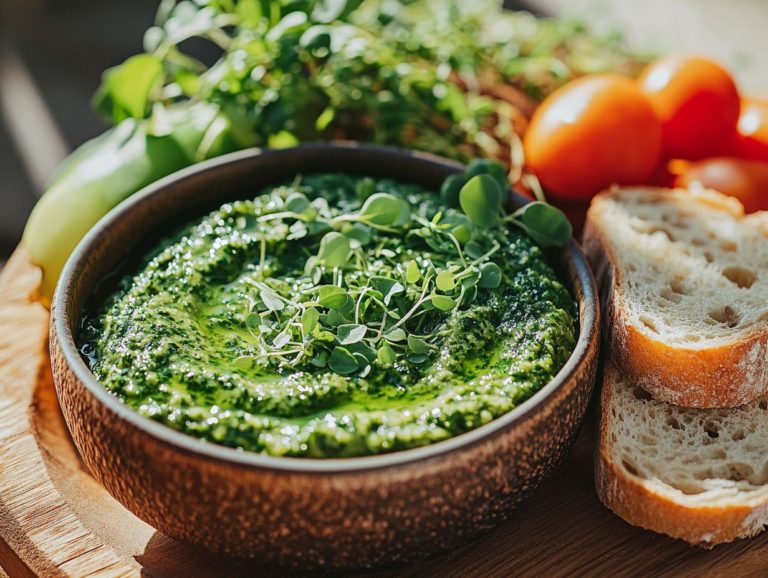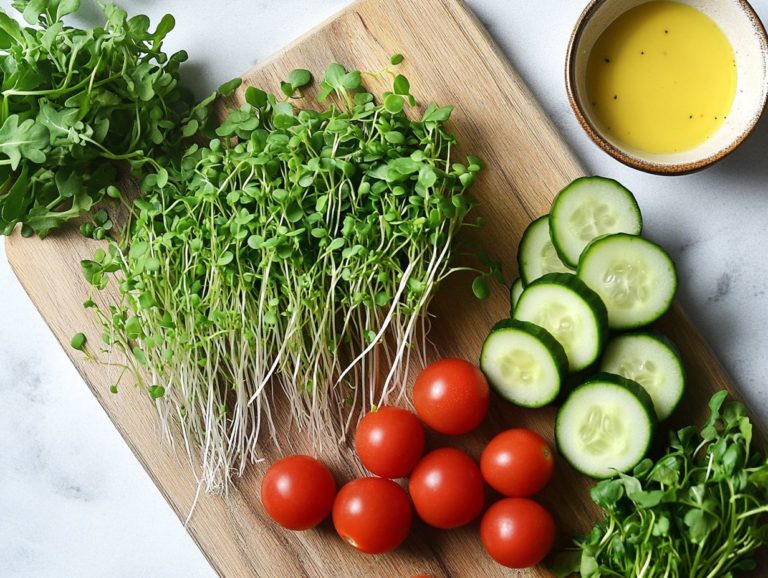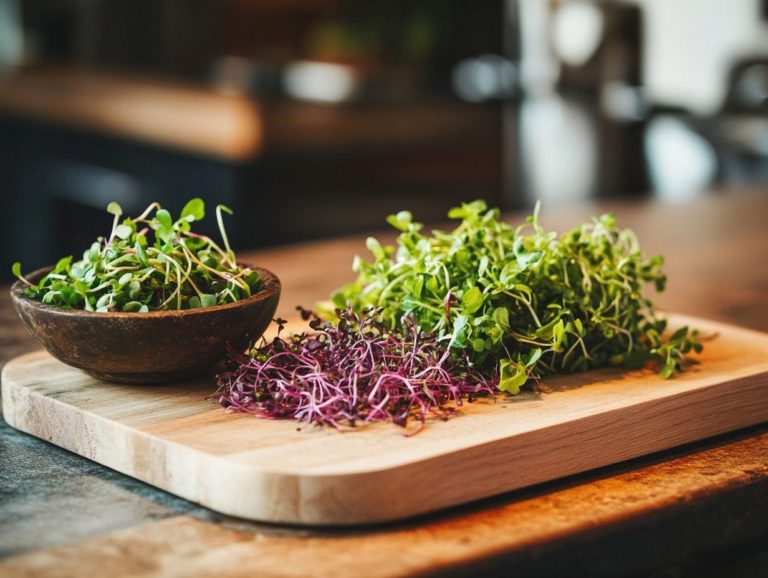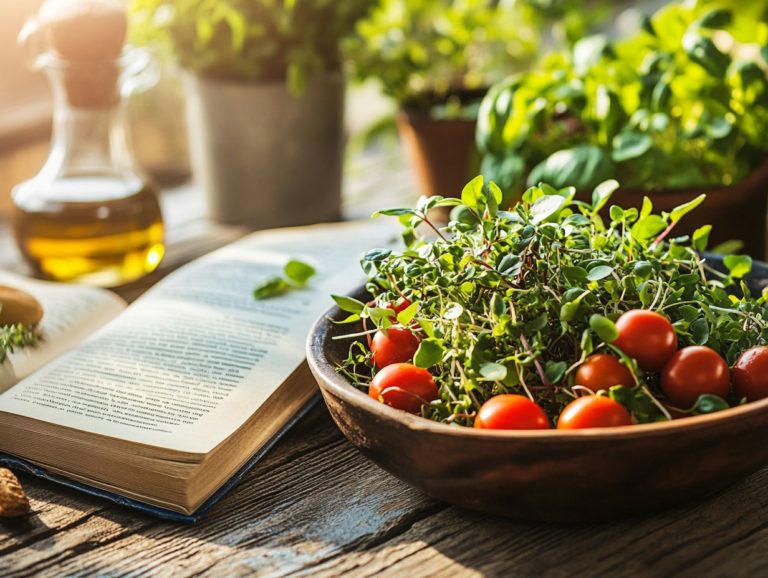74. How to Use Microgreens in Traditional Dishes
Microgreens have transformed the culinary world, providing a burst of flavor and nutrition that can elevate any dish.
These tiny greens are not just a garnish; they are powerful ingredients that enhance even the most traditional recipes.
Explore the benefits of microgreens, learn how to incorporate them into your favorite meals, and discover tips for growing your own at home, including creative uses for these flavorful greens.
Whether you re a seasoned chef or a passionate home cook, discover how these vibrant plants can transform your culinary creations, adding creativity to healthy dishes.
Contents
Key Takeaways:
- Adding microgreens enhances flavor and boosts nutritional value.
- They can be easily included in salads, sandwiches, and flavorful sauces.
- Growing your own microgreens is simple and cost-effective.
What are Microgreens?
Microgreens are tiny seedlings of vegetables and herbs harvested just after the first true leaves appear. Examples include kale, arugula, and sunflower. These powerhouses are rich in flavor and nutrients, making them favorites for salads, sandwiches, and even drinks.
They are easy to grow at home and add a creative flair to your dishes with vibrant colors and textures, enhancing both taste and presentation. You can sprinkle them into various recipes from guacamole to pizza.
Beyond their visual appeal, microgreens have an impressive nutritional profile. They often contain higher concentrations of vitamins and antioxidants compared to their mature counterparts. For health-conscious individuals, incorporating microgreens into your diet is a simple way to boost nutrient intake. Chefs use them to elevate dishes, whether as a garnish on a gourmet burger or blended into smoothies for extra nutrition.
With a growing variety like radish, basil, and beet, it s clear these sprouts play a significant role in modern cuisine, providing both health benefits and extraordinary flavors.
Benefits of Using Microgreens in Traditional Dishes
Incorporating microgreens into traditional dishes enhances flavors and introduces numerous health benefits.
These tiny greens are packed with vitamins and minerals, transforming a simple salad into a nutrient-dense powerhouse while adding delightful taste to sandwiches and sauces.
Experimenting with unique microgreen combinations, such as cilantro, basil, and radish, adds a creative touch to your meals, helping you enhance flavors and support your well-being.
Nutritional Value and Flavor Enhancement
Microgreens are more than just a trend; they are essential ingredients that add a burst of flavor and abundant nutrients. Packed with vitamins like C, E, and K, they support overall well-being while transforming salads, sandwiches, and even drinks into masterpieces. Imagine the spicy kick of mustard microgreens in a fresh salad or the herbal notes of pea shoots in a vegetable dish.
Each type of microgreen offers unique nutritional benefits:
- Broccoli microgreens are known for their high levels of sulforaphane, which may help in cancer prevention.
- Radish microgreens provide a zesty flavor and a generous dose of antioxidants, ideal for tacos and wraps.
- Kale microgreens offer robust flavor and nutrient density, making them great toppings for pizza or a boost in smoothies.
Incorporating these colorful greens into your meals enhances flavor and significantly boosts health benefits. For more ideas on using microgreens, check out how to pair microgreen varieties with dishes, making them excellent additions to any meal.
Try adding microgreens to your next meal or start growing your own to enjoy these delicious and nutritious greens! For more ideas, check out cooking with microgreen varieties: tips and tricks.
How to Incorporate Microgreens into Traditional Dishes
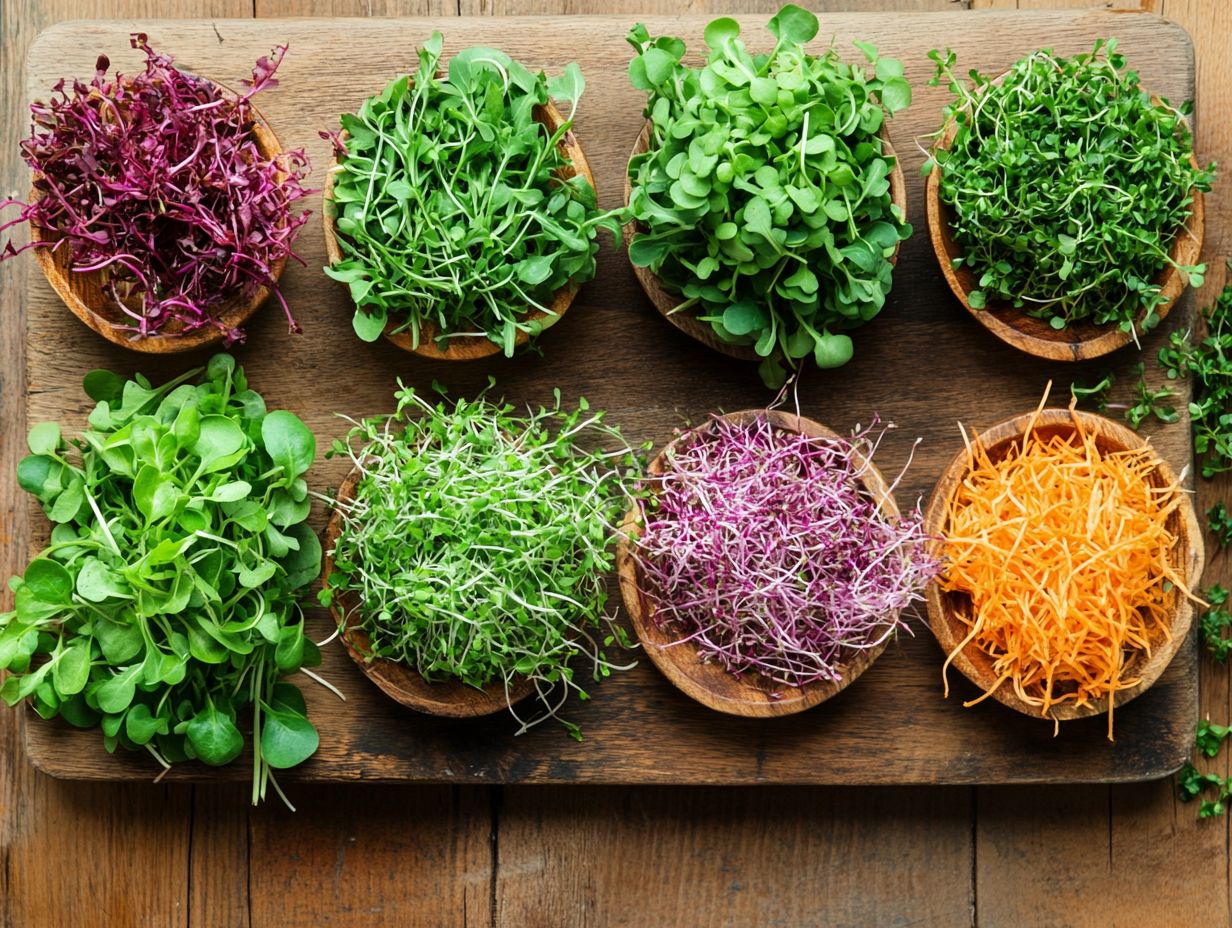
Incorporating microgreens into your traditional dishes truly transforms your culinary experience, elevating meals to new heights of health and flavor. Local ingredients support your cooking.
Imagine adding a peppery kick with arugula in your salads or infusing guacamole with the freshness of cilantro. Microgreens serve as the perfect enhancement for many recipes, showcasing their variety of flavors.
You can creatively layer them in sandwiches, sprinkle them onto pizzas, or blend them into refreshing drinks. This maximizes both taste and nutritional value in every bite while exploring different combinations.
Types of Dishes to Use Microgreens In
Microgreens transform countless dishes, amplifying both the health benefits and the flavors of everything from salads and sandwiches to appetizers and main courses. Their versatility allows you to use them as garnishes or as important parts, bringing creativity and vibrant freshness to your culinary repertoire.
For instance, adding sunflower microgreens to a vegetable salad introduces a delightful nutty flavor. Incorporating spicy radish microgreens into your sandwich elevates the entire taste experience, showcasing their rich textures. Exploring unique microgreens to elevate your dishes can further enhance your culinary creations.
Don’t stop at salads and sandwiches. These tiny powerhouses also enhance soups, stir-fries, and even pizzas. Imagine adding basil microgreens to a fresh tomato soup, which elevates the aroma while imparting a subtle sweetness that balances the dish beautifully. The contrasting flavors of pea shoots introduce a delightful crunch to your stir-fried vegetables. For even more culinary inspiration, explore ways to enhance flavor in microgreens.
As for pizza, topping a margherita with arugula microgreens just before serving adds a peppery finish that harmonizes perfectly with the mozzarella and tomato sauce. These remarkable greens enhance the visual appeal of your dishes and pack in essential nutrients, making them a critical addition to any meal. For more on how to use them, check out the microgreen varieties and their culinary uses.
Tips for Preparing and Serving Microgreens
When preparing and serving microgreens, a few simple tips can elevate their impact on your dishes. Start by washing microgreens thoroughly to remove any residual soil cleanliness is key in the kitchen. Consider using microgreens as a fresh garnish atop salads or sandwiches. This not only enhances visual appeal but also adds an intriguing layer of flavor and texture to your meals.
Proper storage of microgreens is vital for maintaining their freshness. Keep them in a ventilated container lined with a damp paper towel in the refrigerator to retain moisture without inviting rot.
Presentation is equally important. Arrange the microgreens artfully on the plate, allowing their vibrant colors to pop. Thoughtfully incorporated, these tiny greens amplify the visual enjoyment of your dish while infusing it with essential vitamins and minerals, making them an impeccable addition to a healthy lifestyle.
Growing Your Own Microgreens
Growing your own microgreens at home is not only rewarding but also an enjoyable process that brings fresh, nutrient-rich greens straight to your kitchen. This provides a sustainable source for your cooking.
With just a few essential supplies, you can cultivate an exciting variety of microgreens like kale, mustard, and pea shoots. This transforms your meals into vibrant and sustainable culinary experiences that enhance your health.
This approach not only boosts your health but also sparks creativity in your cooking. You can experiment with an array of flavors and textures that only fresh microgreens provide, perfect for new recipes.
Start incorporating microgreens today by checking out this guide on how to incorporate microgreens into your diet and elevate your meals instantly!
Supplies and Steps for Growing Microgreens
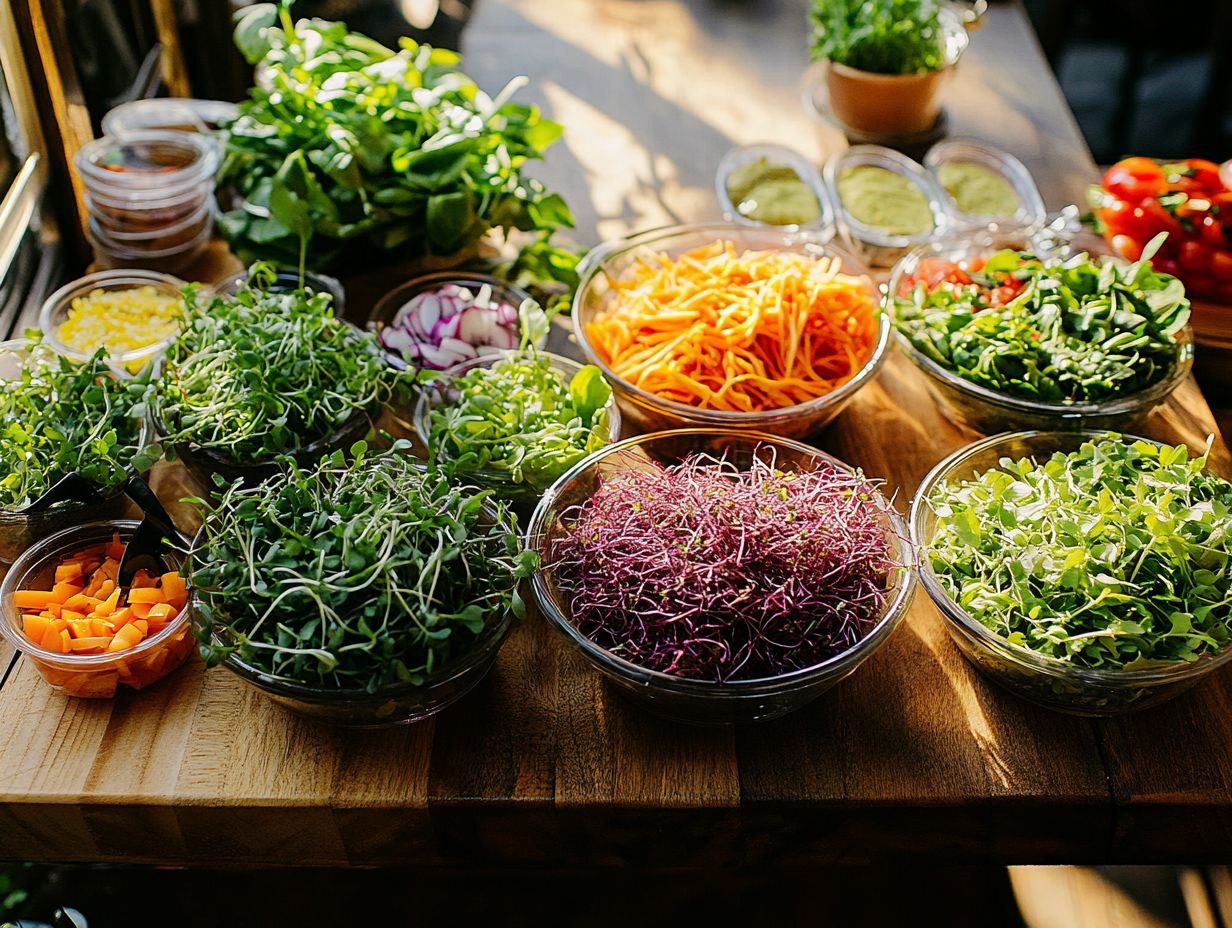
To successfully grow microgreens, you’ll need a few essential supplies: high-quality seeds, a suitable growing medium, and the right containers. Start with exciting seeds like basil, cilantro, or radish these varieties are perfect for your home garden adventure!
Prepare your containers by layering soil, then evenly sprinkle the seeds over the surface. It’s crucial to provide the right moisture and light conditions to ensure robust growth and vibrant flavors.
For containers, choose shallow trays or pots with drainage holes to avoid waterlogging since microgreens thrive in well-drained environments. Pick a soil that retains moisture while allowing for air circulation. After sowing the seeds, mist them lightly to maintain humidity, and consider exploring microgreen varieties in different cuisines to enhance your culinary creations.
Position the containers in a sunny spot or under grow lights for 12 to 16 hours a day, and remember to rotate them as needed for even light distribution. Keep the soil consistently moist, and in 7 to 21 days, depending on the variety, you’ll be greeted by lush greens, ready for harvesting. Incorporating organic fertilizers during their growth can elevate both flavor and nutritional value.
Master the Art of Buying and Storing Microgreens
When buying and storing microgreens, understanding what to look for can truly elevate their freshness and flavor. Always choose vibrant, crisp microgreens that are free from any signs of wilting or discoloration; these qualities indicate premium quality.
After your purchase, be sure to store them in a cool, dry place or refrigerate them to extend their shelf life. This way, you can savor their health benefits in your meals for an even longer time.
Tips for Selecting and Storing Fresh Microgreens
Selecting and storing fresh microgreens properly can elevate your culinary adventures while ensuring they retain their quality and nutritional benefits. Look for varieties that are vibrant and free from any signs of decay or wilting.
Don t overlook the texture; they should feel crisp and firm to the touch, signaling optimal freshness. Aromatic varieties like basil or cilantro add an enticing scent that enhances their overall appeal.
To preserve their quality, avoid stacking them too tightly in storage, as this can encourage moisture buildup and accelerate spoilage. Instead, use containers designed for airflow to let them breathe comfortably.
Storing microgreens in the crisper drawer of your refrigerator will help maintain the perfect temperature and humidity, keeping them fresh for your salads, sandwiches, and garnishes.
Frequently Asked Questions
What are microgreens?

Microgreens are young, edible seedlings of various vegetables and herbs that are harvested after just a few weeks of growth. Bursting with flavor and packed with nutrients, they make a popular addition to many dishes.
Why should I use microgreens in traditional dishes?
Using microgreens in traditional dishes adds a burst of flavor, texture, and nutritional value to your meal. They can elevate the overall taste and appearance of a dish, making it more visually appealing and satisfying for your taste buds.
How do I incorporate microgreens into my cooking?
Microgreens can be added to various dishes, from salads and sandwiches to soups, stir-fries, and more. Use them as a garnish, mix them into a dish, or even replace traditional herbs and greens.
Which types of microgreens work best in traditional dishes?
Many types of microgreens are available, so it ultimately depends on your personal preference and the dish you are preparing. Popular options for traditional dishes include basil, cilantro, arugula, and radish microgreens.
Do I need to wash microgreens before using them?
Yes, it is recommended to wash microgreens before using them in your dishes. Grown in soil, they may contain dirt or other debris, so a quick rinse in cold water is advised to remove any impurities.
Where can I buy microgreens for my traditional dishes?
You can find microgreens at most grocery stores, farmers’ markets, and specialty health food stores. These tiny greens add flavor and nutrition to your meals.
If you want to grow your own, consider using a microgreen growing kit. It’s easy! Just buy some seeds and plant them in a shallow tray or container at home.


